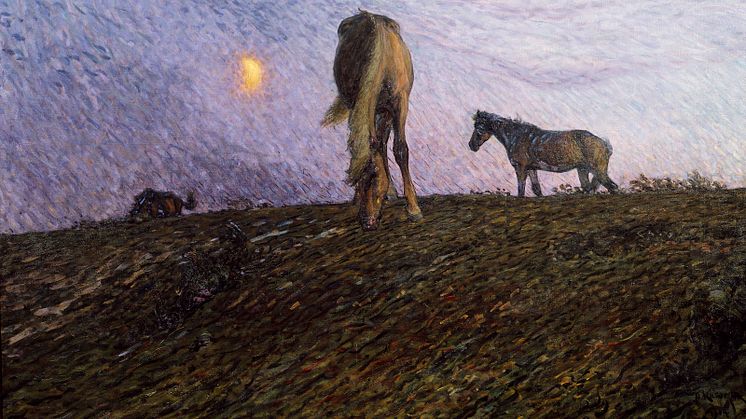
Press release -
Nordic turn-of-the-century art in exhibition at Nationalmuseum Jamtli
The exhibition From Dawn till Dusk – Nordic Art Around the Turn of the Century 1900 opens at Nationalmuseum Jamtli in Östersund on 28 May. Around 130 works will be displayed, including artists like Eugène Jansson, Eva Bonnier, Helmer Osslund, Carl Wilhelmson, Elsa Beskow, Anders Zorn and Bruno Liljefors. The exhibition highlights the artistic development that took place in the Nordic countries around the turn of the century, when artists travelled abroad to paint sun-drenched motifs, and eventually returning painting Nordic landscapes in the twilight hour.
Last year, the art and design arena Nationalmuseum Jamtli was inaugurated, a collaboration between Nationalmuseum in Stockholm and the regional museum Jamtli in Östersund. It is a museum within the museum, featuring exhibitions with key works from the art and design collections of Nationalmuseum. Almost one year later, it is time for exhibition number two with the title ’From Dawn till Dusk’.
” It has been a year since Nationalmuseum Jamtli opened and it has demonstrated how important it is for us to be able to invest in a presence in Östersund. Nationalmuseum is a museum for everyone. This means that our art reaches out to as many people as possible and to achieve this goal we want to develop our regional activities. Now is the time to open a new exhibition with works from our collections and this time the theme is the turn-of-the-century art in the Nordic countries and dusk painting”, says Susanna Pettersson, Director General of Nationalmuseum.
From Dawn till Dusk - Nordic Art Around the Turn of the Century 1900
The last decades of the 19th century were a period of radical development in art in the Nordic region. Young artists grew tired of the conservative atmosphere of the art academies, where history painting was highly valued. One by one, many of the most talented students tried finding their way abroad, in most cases to France and Paris. Suddenly, they experienced freedom - not least the female artists who encountered far better conditions in Paris than those at home. Far from the artificial world of history painting, the artists could instead direct their focus to reality and paint it with the same empathy and seriousness.
Around 1890, there was a call for a clearer national Nordic art. Voices were raised to get the artists to return home in order to paint their own countries in a way that expressed their idiosyncrasies. In Sweden it is possible to describe the development within painting as being like the themes going from dawn to dusk and day to night. This is primarily seen in landscape painting but also in a way in painting portraits, which became more introverted. The exhibition shows a series of dusk themes - from interiors with socialising around tables with candles to suggestive views from Stockholm. The literature was an important entry into the visual arts, for example in Sweden, Strindberg moved about the city in a way that is reminiscent of Charles Baudelaire and Émile Zola. The city soon carried its own mythology, made more influential when combined with the imagination of the reader or the viewer and which strengthened the images and closest dramatic experiences even although nothing takes place in them - a deserted urban space that forms the stage for the imagination of the viewer.
The exhibition From Dawn till Dusk - Nordic Art Around the Turn of the Century 1900 is on display at Nationalmuseum Jamtli from 28 May 2019 until 19 April 2020.
Press Preview
The exhibition will be on display to the media on Tuesday, 28 May between 2:00 p.m. and 3:00 p.m. at Museiplan 1 in Östersund. Representatives from Jamtli and Nationalmuseum will be on site and there will be an introduction to the exhibition held by the curator of the exhibition, Carl-Johan Olsson. Applications are to be sent to christina.wistman@jamtli.com.
Nationalmuseum Jamtli opened on 17 June 2018 and is an arena for art and design experiences in Östersund, where the Jamtli award-winning educational approach is combined with the unique collections and knowledge of Nationalmuseum. Nationalmuseum Jamtli has been made possible through the EU Regional Structural Funds, Östersund Municipality, Region Jämtland Härjedalen and a wide-ranging collaboration with the business community, in which the Postcode Lottery Cultural Foundation, Östersundshem, Länsförsäkringar Jämtland, Persson Invest, Jamtlis Gynnare, Jämtkraft, Jämtlands läns konstförening, Diös, Attacus Invest, Lundstams Återvinning, Oscarson Invest, Toréns Entreprenad AB, Sparbanksstiftelsen Jämtlands län, Föreningen Gamla Östersund and Kvinnliga Föreningen Gamla Östersund are important partners from both a financial perspective and with regard to their other involvement. In addition, Assa Abloy and Bilbolaget also make respective contibutions.
For more information
Hanna Tottmar, Head of press Nationalmuseum, press@nationalmuseum.se, +46 (0)8-5195 4400
Christina Wistman, First Curator Jamtli, christina.wistman@jamtli.com, +46 (0)70-249 19 93
Categories
Nationalmuseum is Sweden’s museum of art and design. The collections comprise older paintings, sculpture, drawings and graphic art, and applied art and design up to the present day. The museum building has currently been renovated and reopened in autumn 2018. Nationalmuseum has partnerships with Svenska Dagbladet, Bank of America Merrill Lynch, The Wineagency and the Grand Hôtel Stockholm.

